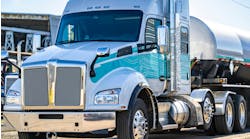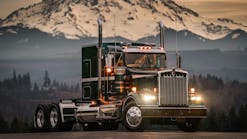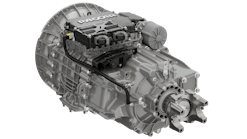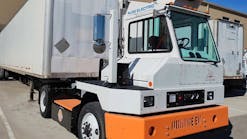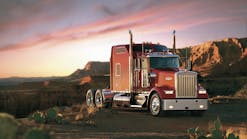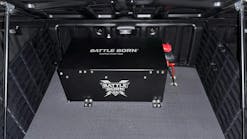VOLVO Trucks North America took a trailer tour around the country in 2016, visiting dealerships, trade shows, and special events.
Chris Stadler, manager of product marketing for Volvo Trucks North America, said there was a lot of interaction with customers about the dynamics of their business and what Volvo can do to help them become more profitable and efficient in their operations.
Speaking during National Tank Truck Carriers’ Tank Truck Week, Stadler said: “More often than not, they come to us and say, ‘We want to improve our bottom line, but don’t want to lose out in the performance of our vehicles. We don’t want our drivers to be unhappy. We want them to be productive. But at the same time, we want to put more money in our pocket.’ They want less fuel consumption but also better performance.”
As a result, here are the improvements and enhancements that Volvo has made for 2017 to improve customers’ bottom line:
• Common-rail fuel system on 2017 D11 and D13 models.
“It’s proven technology,” he said. “We’ve been using it in Europe since 2015. Now we’re introducing it on our engines in the US. We’ve enhanced it and integrated it and put internal pumps into the fuel system. We see a better control of fuel injected into the system and more even flow. We’ve also been able to increase the pressure by 35,000 psi, which gives a cleaner burn with less soot and better fuel economy.”
• New wave piston.
Available in D11 and D13, it increases the compression ratio from 16:1 to 17:1, increasing efficiency. Improved flame propagation increases cylinder efficiency while at the same time reducing soot, and the low-friction Piston Cylinder Unit (PCU) increases efficiency.
• 2017 Volvo D11 updates.
They feature a 2.2% fuel efficiency improvement, new two-piece valve cover, proven common-rail fuel system, new wave pistons, assembled camshaft, shimless rockers, increased horsepower to 425. D11 production began in January.
• 2017 Volvo D13 updates.
They feature a 2.5% fuel efficiency improvement, proven common-rail fuel system, new wave pistons, assembled camshaft, two-speed coolant pump on XE models, and 455 horsepower with torque increased to 1850 lb-ft. D13 production began last October.
• Volvo D13 with turbo compound.
It features a 5.5% fuel efficiency improvement, proven common-rail fuel system, new wave pistons, assembled camshaft, two-speed coolant pump on XE models, and 455 and 500 horsepower ratings at 1850 lb-ft. D13TC production begins in the second quarter.
The D13TC recovers wasted heat and transfers up to 50 additional horsepower into the engine. There are steady state, long-haul down speeding “XE” applications, along with a 3% fuel efficiency increase vs. 2017 D13 when down speeding.
A 2.47 rear axle ratio is available with TC engine and XE package, providing an additional 1% increase in fuel efficiency. It’s available in sleepers where the duty cycle is more conducive to efficiency. There is better throttle response due to increased engine efficiency, and that enhances drivability.
Stadler said both engines can be used in eXceptional Efficiency (XE) or Super Direct configurations. The D13TC should be used in highway applications at cruise speed and for limited time in the city, and the D13 is best for a mixture of pickup-and-delivery and line-haul.
• Exhaust aftertreatment updates.
Stadler said it is lighter weight, takes up less frame rail space, and has an easy filter replacement. There is a swivel cover to help service the DPF faster without detaching the whole unit, and there is the ability to detach the whole unit from the rail when needed in a short time.
• I-Shift.
Improved torsional damping reduces noise, vibration, and wear and tear on the clutch. There is an upgraded countershaft brake for faster shifting performance, and a hardened range housing allows heavier pumps to be used. Production began in October.
• I-See.
I-See is predictive cruise that improves fuel efficiency in rolling hills, taking advantage of trucks’ inertia to save fuel. I-See knows the road ahead and shifts intelligently. It became available in January.
• I-Shift with crawler gears.
It’s based on the 12-speed I-Shift for severe duty technology, with hardened gears. There is an option of a 13-speed with one crawler gear or a 14-speed with two crawler gears. Stadler said it has excellent startability, extremely slow speeds, increased maneuverability, and is perfect for curbing and other slow-speed applications.
• Volvo 6x2 adaptive loading.
Stadler said it provides fuel savings of up to 3-5% and annualized savings in the range of $2000. There is lowered maintenance—tire wear reduction (one tire set/year) and annualized reduction of maintenance costs in the area of $1000. There are curb weight savings of 300 pounds and annualized additional payload (300 lbs x 250 days x 2 hauls per day = 150,000 lbs. per year).
This benefits primarily regional distribution, bulk haulers (liquids, fuel, granular), diminishing load carriers, digital loads (backhaul empty), and van distribution cycles.
Customer benefits include: good traction support, with improved traction in poor weather conditions; better ride stability (less bouncing/snaking) under light load conditions; better steerability in tight turning areas; ease of hooking/dropping trailer; and an automated system to support the driver in load changes.
There is increased fuel efficiency because of the weight benefits of a 6x2 over 6x4 when all axles are down, the forward axle distributes loads, the axle lifted provides 4x2 fuel efficiency, and there is an optimized tire package on the lifted axle tires for better FE.
There is a lower maintenance cost and improved tire wear, reduced brake wear and replacement on the forward axle, PM costs could be reduced, and more consistent load on steer axle provides better front axle tire life. ♦
